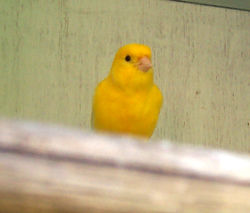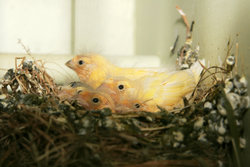
The Canary is a domesticated form of the Wild Canary, (Serinus canaria) a small songbird in the finch family originating from Madeira and the Canary Islands.
Contents |
History
Canaries were first bred in captivity in the 1600s. They were brought over by Spanish sailors to Europe. Monks started breeding them and only sold the males (which sing). This kept the birds in short supply and drove the price up. Eventually Italians obtained hens and were able to breed the birds themselves. This made them very popular and resulted in many breeds arising and the birds being bred all over Europe.
The same occurred in England. First the birds were only owned by the rich but eventually the local citizens started to breed them and, again, they became very popular. Many breeds arose through selective breeding.
Miner's canaries were early forms of carbon monoxide detection in mines. Three or more canaries (or other small birds with high metabolism) were taken down new shafts, and if one or more exhibited abnormal behavior, the parties determined that the shaft was unsafe.
Varieties
Canaries are generally divided into three main groups: Colorbred Canaries (bred for their many color mutations - Ino, Eumo, Satinette, Bronze, Ivory, Onyx, Mosaic, Brown, etc.), Type Canaries (bred for their shape and conformation - Border, Fife, Gloster, Gibber Italicus, Raza Espaņola, Berner, Lancashire, Yorkshire, etc.), and Song Canaries (bred for their unique and specific song patterns - Spanish Timbrado, Roller, Waterslager (also known as "Malinois"), American Singer, Russian Singer, Persian Singer).
Canaries are judged in competitions every fall. Shows generally begin in October and November after the breeding season ends. Birds can only be shown by the person who raised them. They all have unique bands on their legs that indicate the year of birth, the unique band number, the club to which the breeder belongs. Song Canaries are judged later in the year (January).
There are many canary bird shows all over the world. The world show (C.O.M.) is held in Europe each year and attracts thousands of breeders. As many as 20,000 birds are brought for competition.
Keeping Canaries
The keeping of Canaries for their appearance and song is a tradition that dates back centuries.
Most bird veterinarians today recommend a diet of 80% canary pellets. Many breeders still use the canary seed mix available in pet shops. All canaries benefit from a supply of green food such as lettuce, dandelion leaves and nasturtium leaves. They can eat any produce you do, with the exception of avocado. Care should be taken to ensure leaves supplied are clean and have not been sprayed with any chemicals. Canaries also enjoy little bits of fruit, but be careful to offer only what the bird can eat in one sitting, or you may wind up attracting ants, or hornets.
During the moulting period it is advisable to supplement their diet with egg food or nestling food (can be bought as a dry mix to which water is added until a crumbly but not soggy consistency is achieved. Some nestling or egg foods can be served dry, others are best served with a soak seed mix; this is a special mixture of seeds meant to be soaked, rinsed, and sometimes sprouted a little, before being served).
To ensure caged birds are happy, toys should be provided and swapped regularly to avoid boredom (which can lead to aggression and feather plucking). Most people keep males and females in separate cages, except during breeding season. When buying pet canaries, great care must be taken to ensure the right mix of sexes in a cage. A mistake could lead to the birds attacking each other, even to the extent that one may kill another.
In general, pet canaries do not require companionship; the canary species is territorial, not social, and does not generally appreciate company in the same cage. It will be seen as an intruder, not as a companion, and although it might take up to two years or so, if they remain in a single cage all year round, usually one or the other will eventually die. A male and a female stand a better chance of getting along amicably, but all too often the less dominant bird will eventually die, although it may take some time.
This is because the dominant bird will feel the need to constantly 'oversee' the less dominant bird of the two. It will never be able to eat, sleep, or drink its fill in peace, and eventually the stress will take its toll.
If a bird is present in the home and a companion is bought, it must be kept in a separate cage for at least couple of weeks, both for quarantine, and to ensure the birds get used to each other; the new bird can then gradually be introduced to ensure that no fighting ensues. A male and female will often get along reasonably well if introduced in this way, but should not be allowed to remain together all year round; each should have some privacy, during the period from midwinter until the start of breeding season in early spring, at the very least.
Two males will very rarely be happy together, although keeping them permanently in separate cages will prompt them each to sing more than they probably would on their own - however a good recording of canary song will work equally well. A cage with a number of males may work as long as no female is present, but again, they should not be expected to live in peace all year round, and each should be separated into an individual cage during the spring/early summer breeding season at the very least.

Male canaries can mimic sounds such as telephone ring tones and door bell chimes but only if they hear these sounds while young. Canaries can be taught tricks over time but great patience is required as they are fairly timid birds. To get the birds to play with toys, toys must be safely constructed (no sharp edges or parts the bird's feet could become entangled upon).
If pet canaries become ill they will rapidly lose weight and this is why it is essential to treat disease as quickly as possible. It is wise to have glucose powder and an eye dropper in store to administer drops of diluted solution via the beak if a canary stops eating. When a bird is sick, it puffs up its feathers to stay warm; give it gentle heat. You can often drape a heating pad over or under the cage, but be sure the bird can also get OUT of the heat if it wants.
Common household hazards include fumes from the kitchen (cooking fumes and especially fumes from non-stick pans) - canaries should never be kept in a kitchen for this reason. They are also sensitive to smoke from cigarettes, aerosol sprays such as deodorant, air freshener and polish.
Plug in air fresheners/ stand-alone fan fresheners are very toxic, as are some candles, especially scented ones (except unscented beeswax candles).
Avoid placing a canary's cage where it is in a draft, or be in full glare of sunlight without any shade available. If you let your canary out to fly about for exercise, always cover mirrors and windows, as they may fly into them and break their neck.
A number of houseplants/cut flowers are very poisonous to canaries (as are some herbs), so never let them nibble leaves of houseplants. Be very wary, as canaries love to eat greens of all kinds! Safe plants include spider plants, African violets and boston ferns. Clean water must be available for drinking and separate water should be made available for bathing.
Canaries love bathing and should be allowed to bathe often. Offer cold water for them to bathe in, as it improves their feather condition. Warm water, on the other hand, will help to strip essential oils from the feathers, and will encourage itching and picking, rather than preening. Plentiful time to bathe is especially important to a canary during the moult.
Food dishes/cage parts can be safely sterilised in a hot dishwasher or in baby-bottle fluid such as diluted Milton. When it comes to disease, prevention is better than cure. Canaries should be examined for mites and, if mites are found (especially easy to spot around the neck and rump) they can be treated with over-the-counter medication (canary mites don't bite humans). Abnormalities of the skin and feet may be caused by mites and this can also be treated with over-the-counter pet medication. Be aware that dietary problems can cause skin, foot, and feather problems that may look as if they are due to mite damage, so before treating with any drug, get an experienced opinion from a good avian vet on the actual cause of the condition.
Trivia
- Canaries were once regularly used in coal mining as an early warning system. Toxic gases such as carbon monoxide and methane in the mine would kill the bird before affecting the miners. Because canaries tend to sing much of the time, they provided both a visual and audible cue in this respect. The use of Canaries in British mines was phased out as recently as 1986.
- However, Canaries were also used by the first Mercedes-Benz airbag designers. They were often placed in passenger compartments to check for leaks from the airbag.
- Canaries have been depicted in cartoons from the middle 20th century as being harassed by domestic cats; the most famous cartoon canary is Warner Brothers' "Tweety Bird".
- Norwich City, an English football team is nicknamed 'The Canaries' due to the city once being a famous centre for breeding and export of the birds. The club adopted the colours of yellow and green in homage.
See also
References
- McDonald, Robirda, "Brats in Feathers, Keeping Canaries" ISBN 0-9730434-4-X
- Miley-Russell, Marie, "The Practical Canary Handbook, A Guide to Breeding and Keeping Canaries" (especially useful to American Singer canary owners) ISBN 1-5911-3851-5
- Excellent sources of further reading are Linda Hogan's book Canary Tales and GB Walker's wonderful reference, Colour, Type, and Song Canaries. Some commercially published (but less reliable) resources are David Alderton's books Birds Care and You and your pet bird, The Canary Handbook and Canaries, both published by Barrons, Health Care for Birds by Tim Hawcroft and Fife Canaries by James Blake.
External links
You may also find the following sites useful:
- CanaryAdvisor
- Canary Tips Ezine
- Gloster Canary
- Canary List (an email group)
- American Singer Canary
- Flock Talk eZine
- The Canary Cam
- Robirda
- Canary FAQs
- Canary FAQ

A canary nesting
|

Canary, as depicted in the 1851 Illustrated
London Reading Book
|

White Andalusian Canary, 14 years old
|




 216.73.216.91
216.73.216.91 User Stats:
User Stats:
 Today: 0
Today: 0 Yesterday: 0
Yesterday: 0 This Month: 0
This Month: 0 This Year: 0
This Year: 0 Total Users: 117
Total Users: 117 New Members:
New Members:
 216.73.xxx.xx
216.73.xxx.xx
 Server Time:
Server Time: